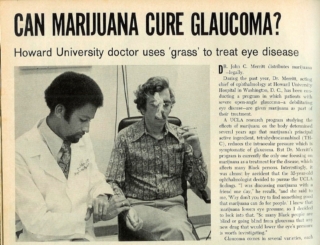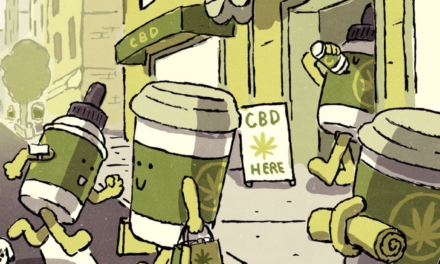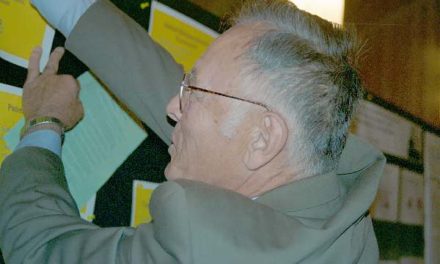I received my undergraduate education from Hampton Institute in Hampton, Virginia. I studied medicine at Howard University College of Medicine. I completed my internship at the University of Illinois Hospital, Chicago, Illinois, and performed my residency in Opthalmology at the University of Illinois Eye and Ear Infirmary in Chicago.
I received a one-year Fellowship in Pediatric Opthalmology to continue my post-graduate studies at the Bascom Palmer Eye Institute in the School of Medicine at the University of Miami in Florida.
I am a board certified Opthalmologist. I am licensed to practice medicine in Illlinois, Georgia, California, the District of Columbia, and North Carolina.
After completing my studies, I returned to the Howard University College of Medicine where I joined the faculty as an Assistant Professor and later became Chairman of the Division of Opthalmology within the Department of Surgery.
In 1978 I resigned my position at Howard University and joined the faculty of the University of North Carolina School of Medicine’s Department of Opthalmology as an Associate Professor. I later became a Full Professor.
In mid-1976, while at Howard University, where I maintained a private practice, I applied for FDA permission to evaluate marijuana’s potential therapeutic value in the reduction of intraocular pressure (IOP).
Drugs which reduce IOP may be of medical value in the treatment of glaucoma, one of the leading causes of blindness in the United States.
My interest in marijuana’s IOP-reducing properties was twofold. First, glaucoma is a leading cause of blindness and improved medical treatments for the disease are critically needed.
Second, glaucoma disproportionately affects people of color. While there are few detailed studies in this area, a National Eye Institute review of data, retrieved from 22 states in 1970, suggested that open angle glaucoma blinded three to five times more non-whites than whites.
My own experiences confirm these reports. Black males may be eight times more likely to develop glaucoma than white males. It is also my experience that black males do not respond as well to conventional glaucoma control drugs and are, as a result of ineffective medical therapies, more likely to become candidates for surgical intervention.
It is also my experience that Black men and other men of color fair less well in surgery than white males and are less likely to have a successful outcome.
For these reasons, it seems particularly appropriate that the Howard University School of Medicine explore the possibility that other drugs, including drugs like marijuana might help glaucoma patients maintain medical control over their conditions and help to prolong sight short of surgical intervention.
While I was in the process of applying for FDA permission to test marijuana’s IOP-lowering properties. Robert Randall became my patient.
For a period of 14 months, November, 1976 , through January, 1978, I provided Robert Randall with licit, medically supervised access to marijuana.
Mr. Randall, a glaucoma patient, had petitioned the government for legal access to marijuana in May, 1976. He was also on trial in the District of Columbia for possession of marijuana. These charges were later dismissed when the court ruled marijuana was a drug of “medical necessity” in the control of Randall’s glaucoma.
Marijuana has proved highly effective in lowering Mr. Randall’s dangerously elevated intraocular pressure into a “safe” range (below 20 mm Hg.)
This reduction in IOP prevented further, progressive injury to Mr. Randall’s optic disc. Marijuana proved to be safe for use within a well controlled medical setting.
Marijuana afforded Mr. Randall with a critically needed reduction in IOP which prevented him from losing more sight. The fact Mr. Randall achieved this reduction short of surgery has helped prolong his sight.
Other Glaucoma Cases
While at Howard University, I also began conducting evaluations of other patients. These evaluations included a basic ocular examination and IOP check. Patients with glaucoma were given marijuana and their IOP response to the drug was evaluated.
Patients came from around the country in an effort to gain access to licit supplies of marijuana. However, Mr. Randall was the only patient I continued to treat on a longterm basis.
In particular, I remember one young man who had come to Washington, DC on a bus from Detroit, Michigan. He arrived at Howard University without prior notice and came to my office. I checked his IOP which was very elevated despite the young man’s use of a number of standard glaucoma control drugs.
After conducting my examination, I provided this young man with some of my federally supplied marijuana, which he smoked in my outer office. His IOP was checked immediately before he began smoking and at regular intervals therafter.
It was clear, based on his IOP response —a significant decline in ocular tensions— marijuana could provide this young man with better control over his IOP. However, he did not live in Washington, DC, and I had received no research funds to hospitalize patients for further observation. Nor could I prescribe marijuana to him or treat him as a research subject over long distances. It would, for example, be impossible for him to return weekly or even monthly for additional evaluations and supplies.
As a result, this young man left my office to hitchhike back to Detroit. He knew —and I know—that marijuana might help to prolong his sight. But I could not legally prescribe the drug to him.
Unable to obtain legal access to marijuana, this young man —if he was smart—bought some marijuana off the street as soon as he got home. The choice between breaking the law or retaining your sight is difficult, but it certainly would be understandable if he opted to preserve his vision.
The situation was not unique. I saw a fairly large number of patients at Howard who, based on my observations, might have gained significant benefit from medically supervised access to marijuana. All I could do was tell them the results of my evaluations. While the law could prevent me from treating these patients, it could not prevent me from informing them.
During these conversations, I did not hint around. Most of the people I saw knew they were losing their sight. Many had undergone years of unsuccessful treatments and numerous surgical procedures. If, based on my evaluations, marijuana demonstrated a value in significantly lowering a patient’s IOP, I made darn sure that the patient knew this and understood the implications.
While I could not provide these patients with legal access to marijuana, I felt I owed them the best possible information and guidance possible. I never told a patient to break the law.
The Inadequacy of Marinol
I left Howard University in January, 1978, to assume a position at the University of North Carolina. In 1980 I received a grant from the National Eye Institute (NEI) to conduct a study into the IOP-lowering effects of marijuana and a number of cannabinoids, including Delta-9 THC.
Unlike my earlier study at Howard, I was, through the University of North Carolina’s Clinical Research Unit, able to conduct longer term in-hospital examination and evaluation of patients.
This grant also included extensive lab work on various chemicals found in marijuana. Earlier studies indicated a multiplicity of chemicals, many unique to marijuana, contributed to the drug’s IOP-lowering effect. Delta-9 THC, while being the most psychoactive chemical in marijuana, is clearly not marijuana’s most effective IOP-lowering chemical.
Delta-9 THC pills are not predictably absorbed and often elicit dysphoric (panic reaction) side effects in elderly marijuana-naïve subjects.
My first experience with synthetic Delta-9 THC pills occurred in November, 1976, when I evaluated Mr. Randall’s IOP response to this form of therapy. The pills supplied for Mr. Randall were later found to contain less than the stated amounts of active Delta-9 THC (most likely due to chemical degradation) with age. Mr. Randall had no reduction in IOP following his use of synthetic THC. Marijuana, however, clearly provided Mr. Randall with significant, longterm reductions in IOP.
Clearly, for some patients, synthetic Delta-9 THC simply failed to reduce IOP.
There was a second problem in trying to use synthetic Delta-9 THC within the context of glaucoma therapy. Synthetic Delta-9 THC is highly psychoactive (mind altering). Glaucoma treatment requires the chronic, longterm use of drugs to control IOP. It quickly became apparent that synethic Delta-9 THC induced dysphoria.
When it became clear synthetic Delta-9 THC pills were not an effective alternative means of achieving the IOP reductions possible with marijuana, the government, through the National Eye Institute (NEI) began funding efforts to transform synthetic THC into a topical (eyedrop) agent.
There are a number of reasons why this approach was doomed to failure. First, the studies which suggested THC eyedrops might be effective were conducted on rabbits. There are no good animal models for glaucoma. Second, THC is not a water-soluble chemical and had to be suspended in sesame seed oil. Third, THC is a very large-molecule chemical. All other topical preparations for glaucoma tend to be based on small-molecule chemicals which can penetrate the eye.
This attempt to develop an effective THC-based eyedrop consumed funds which should have gone into basic research on marijuana’s immediate therapeutic value to glaucoma patients, and into longer term studies into the natural products model of action.
The folly of the NEI’s cannabinoid eyedrop approach was graphically illustrated in mid-1978 when the preparation was tested on the first human subject. Human studies with topical cannabinoids have been confounded with vehicle problems. After four more years of evaluation —which involved very few patients, NEI declared the THC eyedrop a failure.
Between 1980 and 1985, I continued my studies at the University of North Carolina. During this period, I conducted short-term IOP response tests using marijuana and/or synthetic Delta-9 THC pills on approximately 40 patients. These evaluations were often conducted over a three-day period. On the first day, patients would be hospitalized and given a complete ocular examination. These examinations would include tests of visual acuity and fields.
During this first day, repeated measurements of the patient’s IOP would be taken at predetermined intervals. These IOP readings helped establish a “baseline” on the patients which could be used later for comparison.
Patients who entered the hospital were told to stop using their conventional glaucoma control drugs at least two to four days before entering the hospital for evaluation.
On the second day, the patients would be provided with marijuana. IOP checks would be performed immediately prior to the patient’s smoking and at predetermined intervals thereafter. These routinely included IOP checks at 0, 15, 30, 45, 60, 90, 120, 150, 240 and 300 minutes following the use of marijuana.
On the third day, this sequence of testing would be repeated with slight modifications, depending on the results of the previous day’s data.
In addition to these in-hospital evaluations, I provided marijuana to between four and six patients on a longer term, outpatient basis. These patients, who demonstrated a significant reduction in IOP after smoking marijuana,were often able to reduce their use of glaucoma control drugs while smoking marijuana.
Realizing that many glaucoma control drugs have serious adverse effects, marijuana can assist in reducing the risk of such side effects. One glaucoma control drug, Diamox, a diuretic, can cause patients to feel fatigued and depressed. Diamox can also destroy a patient’s kidneys. In some instances, the use of marijuana can allow the physician to reduce or eliminate Diamox from a patient’s therapy. If the patient has a serious kidney problem, marijuana IOP-lowering properties may help control the patient’s condition. If marijuana were not available and the use of Diamox was precluded, the patient’s only other alternative might be surgical intervention.
No one I know of seriously speaks of using marijuana as the initial drug of choice in glaucoma therapy. However, marijuana has an important place in the treatment of patients in end-stage glaucoma.
“End Stage” glaucoma can be described in several ways. Essentially, it defines a patient who has already lost substantial amounts of vision. Available glaucoma-control drugs are no longer able to adequately reduce IOP to prevent further, progressive sight loss. The patient, lacking additional IOP reductions, will go blind.
Robert Randall represents one type of end-stage glaucoma, which implies that his visual fields and optic nerves have been severely compromised. In effect, despite Mr. Randall’s use of all available glaucoma control drugs at the highest permitted dosages, his IOP remained beyond good medical management. Left in this condition, Mr. Randall would have gone blind.
Marijuana’s additional IOP-reducing effects can provide patients already using conventional therapies with critically needed reductions in IOP that help to stabilize the patient’s vision. This is what occurred in Mr. Randall’s case.
While his glaucoma could not be controlled with conventional medicines, marijuana, in combination with some of those medicines, allowed Mr. Randall to regain control over his IOP short of surgical intervention.
If marijuana failed to work, Mr. Randall would still have the option of surgery to correct his elevated IOP. Surgery, however, should be viewed as a “last resort” procedure Because of its risks, particularly in a young patient like Mr. Randall.
I should note that glaucoma primarily strikes older individuals, usually adults in their mid- to late 50s and early to late 60s. Mr. Randall is very young relative to most glaucoma patients. Until recently, it was felt very few people Mr. Randall’s age got glaucoma. However, as information is better collected, it appears now glaucoma among younger adults is much more common than once believed.
There is another class of end stage glaucoma patients. These are patients who, despite all available therapies, medical and surgical, cannot gain control over their elevated IOP. Many of these patients admitted into my program at the University of North Carolina had undergone multiple surgical procedures in an effort to gain control over their IOP. These procedures had failed and the patients urgently needed to find another way to lower their IOP into a safe range before they lost even more vision.
There is one final group within end-stage glaucoma: patients who are blind. All of the emphasis in glaucoma treatment is designed to prevent blindness. What is seldom discussed are the problems confronted by patients who, while blind, continue to suffer from the consequences of elevated ocular tensions.
If uncontrolled, these elevated ocular tensions may, in blind patients, result in serious additional injury to the eyeball. In many cases the final outcome of failure to control these problems —and the elevated eye pressure which drives them— will result in the surgical removal of the eye.
Marijuana, by adding to the IOP reductions available to patients through the use of conventional medications, may bring IOP under control and allow the patient to retain his eye.
As a result of my evaluations and studies into marijuana’s IOP reducing effects conducted over the last decade, it is clear to me marijuana can be of significant benefit to glaucoma patients with “End Stage” glaucoma.
Marijuana can dramatically reduce IOP, even in patients who are tolerant to most forms of IOP reducing agents.
When patients receiving marijuana on an outpatient basis were evaluated, it became clear that these patients required less potent and/or fewer conventional drugs to help their glaucoma.
Marijuana is not without side effects. While performing my studies at the University of North Carolina, I encountered several instances where marijuana inhalation resulted in a sudden, dramatic reduction in blood pressure. This problem, orthostatic hypotension, seen in approximately three patients, was never life-threatening, but it was very disconcerting. Treatment of this side effect consisted of having the patient lie down for a few minutes until blood pressure recovered.
Efforts to track down the reason for this response have proved inconclusive. Initially, we felt that these patients, two of whom were naïve smokers, might not be properly titrating themselves. Marijuana, because it is inhaled, allows patients to exercise considerable control over the delivery of a dose. However, naïve smokers, lacking prior experience, might be inhaling too much delta-9 THC and/or other chemicals. This mini-overdose possibly triggered the collapse in blood pressure.
Serum delta-9 THC levels failed to correlate with orthostatic hypotension in the three subjects encountered.This orthostatic hypotensive response may be more likely in patients with essential hypertension and glaucoma. In all subjects, this response is abated within 10 to 15 minutes by assuming a reclining position.
Determining what drugs are appropriate within the context of medical therapy is a constant balancing of benefits and risks. All of the drugs employed in glaucoma control therapies have serious adverse effects.
In a recent review of Timolol’s use over the past eight years in glaucoma therapy, a journal article noted that 32 deaths have been attributed to Timolol up to 1986.
Similarly, all of the other drugs employed for IOP reduction can have serious, even life-threatening adverse effects. These adverse effects include kidney stones, ulcers, drug fevers, depression, hallucinations, anxiety, mania, skin rashes, headaches, cataracts, bone marrow depletion, reduced immunosystem response, and a host of other serious problems.
The IOP-reducing drugs currently approved for use in glaucoma therapy as “safe” can cause death, in rare instances, due to respiratory and/or cardiac failures.
The most significant side effect we noticed in our studies was a sudden drop in blood pressure. No emergency countermeasures were required, no drug antidotes were used. All of the patients recovered within a matter of 10 to 15 minutes. There was no long-term injury, mental or physical.
Clearly, marijuana is safe for use under medical supervision.
Marijuana’s inappropriate classification as a Schedule I drug prohibits physicians from supervising a patient’s use of marijuana. It is an invitation to chaos.
One of the great frustrations I confronted in conducting my studies, both at Howard University and at the University of North Carolina, was my inability to provide patients with licit, medically supervised access to marijuana because of the drug’s misclassification and the limitations of my IND.
While at the University of North Carolina, I often evaluated a patient for whom it was obvious marijuana was of benefit. Since most of the patients I saw in this study had “End State” glaucoma, my inability to respond to the data was more than simply frustrating. To the patient, my inability to provide prescriptive access to marijuana could well mean the difference between continued vision and unnecessary, progressive sight loss ending in blindness.
The ethical and moral stress of such a situation is not tolerable. As a physician I am trained to provide care, and to protect my patients from unnecessary harm. The law, however, prohibits me from extending care to these patients.
As noted above, the law cannot prevent me from at least providing patients with an honest and complete assessment of their conditons, and of marijuana’s effects on their IOP.
Realizing many patients, so informed, will do the sane thing and obtain marijuana, illegally if necessary, to sustain their sign, I take the further precaution of providing these patients with a letter. The purpose of this letter is to certify that the patient has glaucoma and that, when tested, marijuana proved to be helpful in lowering the patient’s IOP.
In 1985 I concluded my studies. During the course of my studies into marijuana’s use in the treatment of glaucoma, I authored and coauthored fourteen articles and three abstracts on this subject.
Certainly, based on my findings, marijuana should be available, on a prescriptive basis, as an option available to glaucoma patients. As in any medical situation, a final determination on the therapy’s value should be made by the treating physician in consultation with the patient.
Under no circumstance should such decisions be made by distant bureaucrats who lack medical training and who appear to be more concerned with political appearances than with the welfare of seriously ill patients.
After completing my study, and unable to secure additional federal funding for further evaluations of marijuana’s use in glaucoma therapy, I decided to leave the University of North Carolina and return to private practice. I established a practice in Durham, N.C. and have greatly enjoyed the transition.
The idea of dealing with a Schedule I drug is frightening to nearly all practicing physicians and unsettles even experienced researchers. It is not something a physician does in the normal course of business.
None of the more than 40 patients I evaluated at the University of North Carolina was able to locate a physician willing to “sponsor” an IND program through the FDA…
Marijuana’s present classification is in error. The Drug Enforcement Administration in reviewing this matter must come to grips with the data and realize our understanding of marijuana has advanced beyond the confines of Schedule I.





